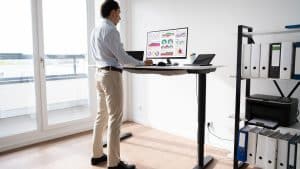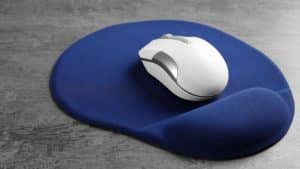Posture Damage Due To Home Office

Working from home offers various advantages for companies and their employees. However, the latter are increasingly complaining about joint pain and posture problems. No wonder, because all too rarely are workspaces in the home environment set up optimally. Here are seven preventive tips from a physical therapist.
Posture damage contracted in the home office are reason enough to change something in one’s immediate environment. It’s often the small measures that bring real benefits, knows Alexander Srokovskyi, physiotherapist and osteopath. Above all, many postural defects can be prevented with regular breaks and a little exercise. He explains the best way to do this in the following seven points.in den folgenden sieben Punkten.
1. set up multiple workstations
First of all, it makes sense to set up not just one workstation at home, but two variants right from the start: One for sitting, the other for working while standing. Both areas should be connected in such a way that it is possible to switch effortlessly at any time.
2. exercise is good against posture damage
It’s also a good idea to rest for a moment every 30 to 60 minutes or so. These breaks are important to get some exercise. At the same time, open the window to let fresh air into the home office. This benefits not only posture, but also thinking performance.
3. observe the 3 minute rule
If you’re looking for more than just a little exercise, you can incorporate small work-outs into your breaks at work: Just three minutes a day is all it takes. This way, you can strengthen your body and recharge your batteries for the rest of the day’s work.
4. continuity wards off posture damage
However, most changes do not succeed overnight. It takes a little time to integrate them firmly into everyday life and let them become rituals. Stick it out for 66 days. Continuity pays off, because by then things have become routine and suddenly come easily.
5. strengthen the muscles in between
During a long day at the home office, the need to stretch grows. However, it would be even better to do a few exercises to strengthen the muscles. This will ensure more stability in all areas of the body in the long term and at the same time provide more mobility.
6. exercises against tense neck muscles
Even in the home office, an exercise to loosen the muscles should not be missing. A particularly effective workout: For this, the hand with the thumb inside is closed into a fist and the arm is stretched horizontally outwards and then turned inwards. The shoulder of this arm is pressed down and the head is tilted to the opposite side. A soothing tension is created in the neck muscles. Hold this for three seconds at a time. The exercise should be repeated ten times per side.
7. targeted movement against posture damage
Place the legs shoulder-width apart and move the arms a little away from the body with the fingers spread and extended. Now squat slightly by moving the knees back toward the heels and increasing pressure on the ball of the big toe and the outside of the foot. By placing a slight outward tension on the arms and pressing the feet into the floor, a tension is created that should be held for three seconds at a time with full concentration. This exercise is repeated ten times.
Some further tips to avoid posture damage
It makes sense to set up the workstation according to your own physical needs. For example, using a monitor stand to raise the screen. Laptop stands even allow a tilt angle that enables the desired positioning of the device. A mouse pad with a hand rest is easy on the wrists, and a footrest is a valuable relief for the lumbar spine. Seat and lumbar cushions also help prevent posture problems.

C&C-Autor aus Baden-Baden
Alexander Srokovskyi, Geschäftsführer der ProVita Physiotherapie in Baden-Baden, bietet seinen Patienten als Experte eine ganzheitliche und wissenschaftliche Diagnostik und darüber hinaus eine Behandlung in einem familiären Umfeld.


